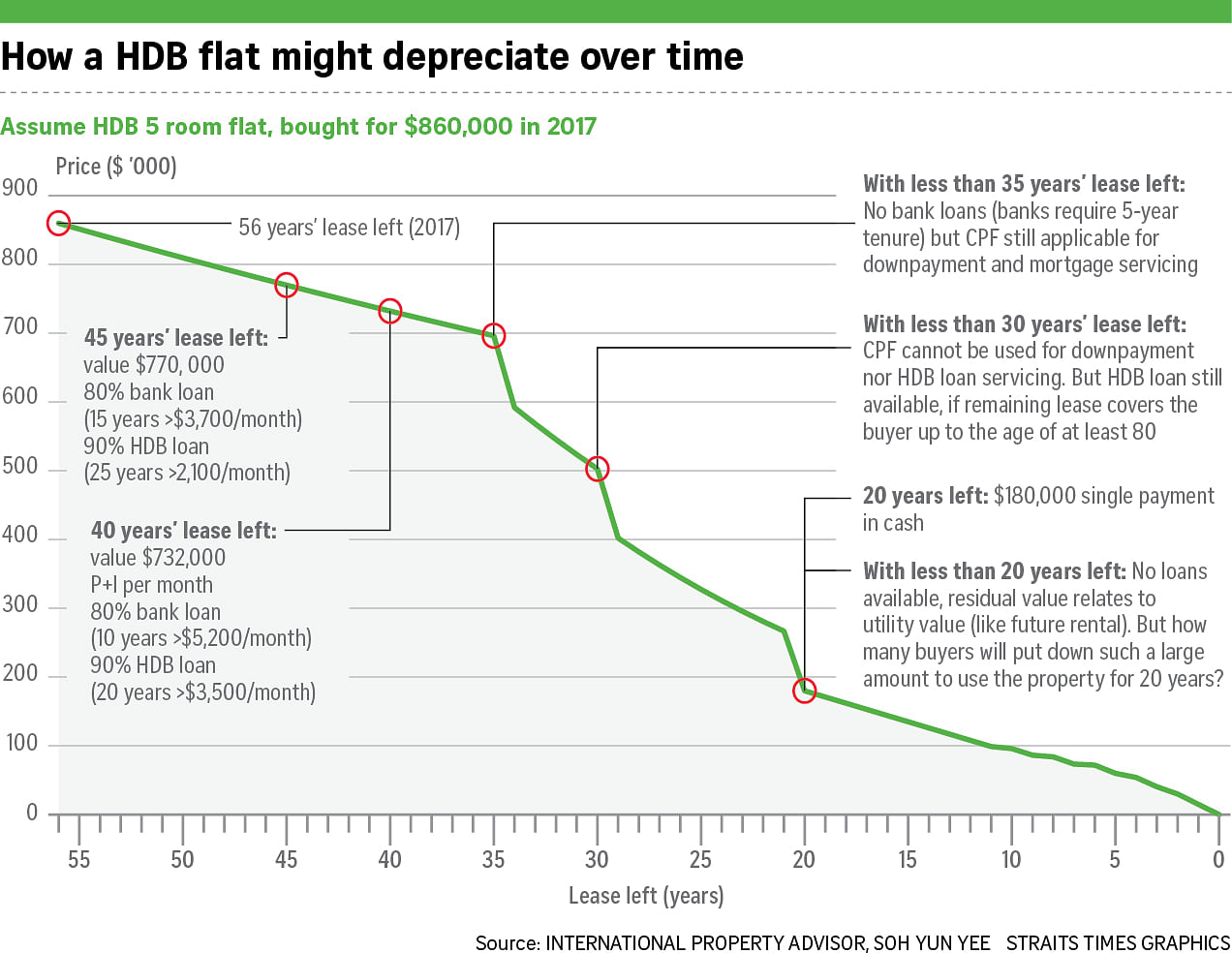In the natural order of things, depreciation sets in as the lease on a property decays over time - meaning as the asset ages, its value should fall in tandem.
Housing Board (HDB) flats which are mostly sold on 99-year leases, however, appear to defy this logic - at least for now - supported by healthy home demand and the growing economy.
Values of older flats in mature estates remain resilient, with some choice units fetching high prices. A five-room flat in Queen's Road went for $950,000 last year despite having only 57 years left on the lease. That worked out to be $706 psf based on a size of 1,346 sq ft, consultancy OrangeTee said.
But prices are unlikely to keep rising through the flat's 99-year lease. The likelihood is that values will fall at a faster clip when the flat's remaining lease is below 35 years.
OLD IS GOLD?
Property agents say buyers may prefer older flats as they are more spacious. Also, some buyers may want to live near their parents in mature estates.
Buyers may also bank on their HDB block being picked for the Selective En bloc Redevelopment Scheme (Sers). Under Sers, the HDB acquires ageing blocks for redevelopment. It compensates residents at market rate for their old flats, and lets them buy new units nearby at subsidised rates.
"From our engagement with buyers of old leasehold flats, it seems that most (think) they would qualify for Sers well before the end of the 99-year lease," noted Mr Eugene Lim, key executive officer at ERA Realty Network.
Such speculative buyers are willing to pay up to a 10 per cent premium over the market price for the old flats, PropNex Realty chief executive Ismail Gafoor said.
Such unrealistic mindsets prompted a blog post by National Development Minister Lawrence Wong last month, urging home buyers not to assume that all old flats will be selected for Sers. In fact, only 4 per cent of HDB flats have been identified for Sers since 1995. The vast majority of flats, Mr Wong noted, will be returned to HDB when their leases run out.
TIMELY REMINDER
Observers say Mr Wong's comments are a timely reminder and a reality check for those over-paying for old flats, or buying them in hopes of profiting from Sers.
It also creates an opportunity to educate home buyers on issues relating to HDB lease decay as flats continue to age.
There are about one million HDB flats. Of these, 70,000 or 7 per cent are more than 40 years into their leases. About 280,000 units are between 30 and 40 years old, according to HDB figures. That works out to about one in three flats being 30 years or older.
More than just a roof over the head, public housing and home ownership has been a key pillar of Singapore's nation-building. HDB flats are also seen as a store of value that can be unlocked when needed. They are also regarded as a reasonable hedge against inflation.
The issue of decaying HDB leases and addressing the implications on retirement adequacy will pose a challenge for the Government in the decades to come.
"It will have to manage expectations that a sizable number of HDB home owners will see the value of their flats being zero at the end of their 99-year lease," said Singapore Management University (SMU) law don Eugene Tan.
Mr Christopher Gee, senior research fellow at the Institute of Policy Studies, said: "Retirement security for a majority of Singaporeans is dependent on the housing market cycle, and the presumption that housing prices at least preserve their value over time."
PRICES STILL HOLDING UP
Property agency ERA said 1,869 flats with 60 years or below of lease were sold last year, up by about 11 per cent from the 1,679 units transacted in 2015. Deals involving such old units account for less than 10 per cent of total resale HDB transactions last year.
Average resale prices of flats with 60 years and under of lease was $364,052 in 2016, relatively stable compared with $364,264 in 2015, said Mr Lim of ERA.
Real estate portal SRX Property, meanwhile, said buyers appeared to be "rather agnostic" about the price of flats aged between 25 and 50 years, based on its analysis of HDB resale transactions in at least three estates last year.
For example, the median per sq ft price paid for flats in Bedok with lease commencing in 1970 (aged 46 years in 2016) was $407, just slightly lower than $414 for those built in 1995 (aged 21 years). Median transaction prices were much higher for newer flats built after 1995.
Dr Tu Yong, associate professor at the National University of Singapore's Department of Real Estate, noted: "Lease decay and depreciation is natural. But other factors like location and demand may push up the value, so the effects of lease decay are not so obvious."
Property prices are also dependent on factors such as size of units and their rarity. Rare terraced flats, for instance, accounted for most of the top five HDB deals for older units last year, said OrangeTee. For example, a four-room terraced flat of 1,163 sq ft in Stirling Road, Queenstown, was sold for $980,000 last year, with 51 years of lease left.
DEPRECIATION: AN ILLUSTRATION
So HDB flat prices are robust now - but will it be so 10, 20 years later, as more hit 50, then 60 years old?
It is hard to ascertain the pace at which flat values will fall. There is no available information on the rate of value depreciation for HDB flats with each passing decade.
However, analysts expect property values to drop more sharply towards the tail-end of the lease when loan restrictions and constraints in using Central Provident Fund (CPF) savings to finance the flat kick in.
International Property Advisor chief executive Ku Swee Yong said there are possibly three key points in the flat's lease cycle that will mark steeper falls in value as its resale appeal wanes, due to financing restrictions.
First, at less than 35 years of lease left when banks are unwilling to extend loans to finance their purchase. That applies to flats that are at least 64 years old.
Second, at under 30 years' lease remaining when CPF money cannot be used for down payment or to service the monthly mortgage (flats that are 69 years old). And third, when leases go under 20 years (flats that are 79 years old).
"When leases drop to 20 years and below, the prospective buyers will not be able to get HDB loans, bank loans or use CPF for the purchase. Everything has to be paid in cash in one go," Mr Ku noted.
The amount of CPF money that can be used to finance the flat purchase is also lower for units with a remaining lease of at least 30 but under 60 years.
Even before these key milestones, owners may start to find it difficult to sell their ageing units, Mr Ku said. He offers an example: A buyer pays $860,000 for a 43-year-old five-room flat in a mature estate, with 56 years left on the lease in 2017. Say he wants to sell the flat in 2033, with 40 years of lease left. Assuming the flat is in good physical condition, and its price falls at 1 per cent a year, it would be valued at $732,000 then.
If rules don't change, a buyer can only get a bank loan with a 10-year tenure to finance the flat, or an HDB loan with a 20-year tenure.
For a bank loan, the monthly mortgage payment will be $5,200 (for an 80 per cent loan over 10 years) and $3,500 for an HDB loan (90 per cent loan over 20 years).
"How many households would want, or have the ability, to service that kind of mortgage?" he asked, adding that households can choose newer flats with longer leases, and take loans with longer durations and lower monthly mortgages.
This could make re-selling pricey older units challenging.
99-YEAR LEASE CLOCK
Market watchers are divided on whether Minister Wong's comments on Sers will immediately dent sales prospects for older flats. "For now, because of overall demand, prices of HDB resale flats will not be negatively affected," says PropNex chief Mr Ismail.
However, property consultancy Edmund Tie & Company believes it may dampen demand especially for highly priced old units. It noted that there has been more discussion on the lease issue among buyers recently.
"There's more awareness, people are concerned if they put in a lot of money in the flat, whether they can recoup it in the future... We may see prices of the more expensive units easing 3 to 5 per cent this year," said Dr Lee Nai Jia, head of South-east Asia research at Edmund Tie & Company
To be sure, this matter of lease decay is not new. Every flat buyer ought to know that an HDB flat comes with a 99-year lease at best, and the buyer's rights are in accordance with the terms and conditions in the HDB lease agreement.
Ms Tang Wei Leng, managing director at Colliers International, Singapore, said: "The HDB owner or lessee has paid a price for the right of use to the property for the lease period. It is therefore fair that the value will run down to zero when the lease expires."
Sers is a niche programme affecting 80 sites so far. It rejuvenates ageing estates and gives flat owners a chance to get a new home with a fresh 99-year lease. But it is an expensive undertaking for the Government, which has said it will continue to offer Sers but only very selectively. In fact, SMU's Associate Professor Tan said he won't discount the possibility that Sers might be scrapped in future for fiscal reasons.
Barring any new schemes, this means most HDB flats will go back to the state once the lease is up.
Flat buyers would best not think of the 99-year lease as a clock that can be reset, but as a guide to planning their home purchase - ensuring the unit meets their budget and needs over the lease period.




